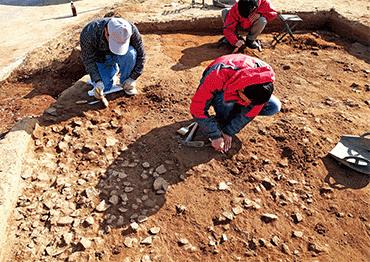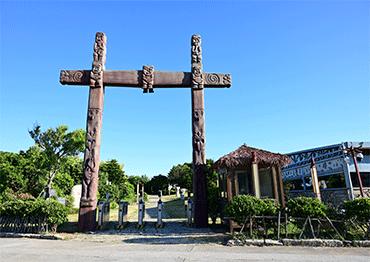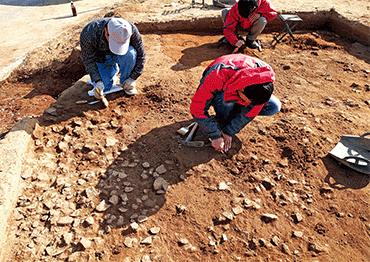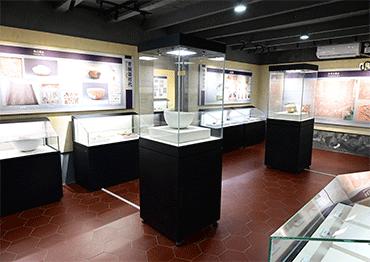
Archaeologists excavate pottery, bone tools and ancient rice grains dating back 5,000 to 6,500 years at Keqiutou Neolithic Site, Pingtan, Fujian Province, April 2017 (Photo Courtesy of Pingtan International Institute of Austronesian Research
A major chapter in the story of humanity’s maritime past has come to light with the recent opening of the Keqiutou Site Branch of the China Archaeology Museum in Pingtan, Fujian Province, on April 9.
Located on a quiet stretch of coastline in southeastern China, the museum is more than an institutional milestone. It marks the symbolic and scholarly recognition of groundbreaking discoveries made in recent years that trace the roots of the Austronesian peoples, a seafaring cultural and linguistic group spanning the Pacific, to the Chinese mainland.
The term Austronesian was coined by German-Austrian anthropologist Wilhelm Schmidt in 1899, deriving it from the Latin for south (auster) and the Ancient Greek for island (nêsos), to mean the “southern island language” group.
Today, Austronesian peoples refer to indigenous ethnic groups of Taiwan and parts of Southeast Asia, as well as Micronesia, Melanesia, Madagascar, Rapa Nui (Easter Island) and Polynesia – including New Zealand (Aotearoa) and Hawaii. Migrations started 6,000 years ago and lasted until around 1,000 years ago. About 400 million people speak some 1,200 Austronesian languages in the world.
For decades, many archaeologists had placed Taiwan as the origin and linguistic homeland of the Austronesian expansion, often known as the “out-of-Taiwan” theory.
But archaeological discoveries made in recent years challenge this. At Keqiutou Site Museum, over 600 artifacts recovered from Keqiutou and adjacent sites across Pingtan are on display. They range from pottery and bone tools to ancient rice grains and shell ornaments, all dating back 5,000 to 6,500 years.
These artifacts strongly resemble those found at Austronesian sites in Taiwan. Kwang-chih Chang (1931- 2001), a renowned archaeologist from Taiwan whose interdisciplinary research focused on ancient East Asia, was among the first to notice the similarities between artifacts found in Fujian and Taiwan. Chang led the excavations in the 1960s of Dabenkeng, the oldest-known Austronesian site on the island.
During a visit to Keqiutou in 1987, two years after excavations began there, Chang noticed similarities between the Keqiutou and Dabenkeng cultures. He argued that Dabenkeng culture originated on the Chinese mainland.
As the concept of Austronesian origins remained a novelty among mainland archaeologists and cross-Straits academic communication was limited, Chang’s theory initially attracted little attention. However, with groundbreaking discoveries made in recent years, especially since 2021, the mainland-origin theory has become mainstream in Austronesian origin studies.
At the Xiying site, part of the larger Keqiutou cultural cluster dating back approximately 6,500 to 7,500 years ago, DNA extracted from human remains reveal a strong maternal genetic link to both Taiwan’s indigenous peoples and Austronesian-speaking populations of Southeast Asia. One individual exhibited a distinctive dental modification – removal of the central incisors – a coming-of-age ritual that survives among some indigenous communities in Taiwan today. The combination of genetic and cultural evidence points to a close, continuous relationship between prehistoric populations on both sides of the Taiwan Strait.
In a study published in world leading botany-focused journal Frontiers in Plant Science in July 2022, a team of scientists from Peking University, Academia Sinica of Taiwan, the University of Guam and the Australian National University conducted radiocarbon dating and other tests on rice and millet remains from various sites and periods. They concluded that the southeast coast of China was the origin of proto-Austronesian peoples, who acquired their crops and other farming traditions from the Yangtze Valley, then brought them across the Taiwan Strait about 4,800 years ago and eventually farther into Southeast Asia.
According to Fan Xuechun, president of the Pingtan International Institute of Austronesian Research, early Austronesian-speaking ancestors were already navigating the Taiwan Strait by around 5,000 years ago. “Evidence shows that cross-Strait travel was frequent and likely involved multiple waves of migration and cultural integration, not the result of a single migration followed by long-term isolated evolution,” Fan told NewsChina.
In 2002 and 2003, Fan led joint excavations with scholars from Harvard University and the University of Hawaii at Damaoshan, another crucial Austronesian site on Fujian’s Dongshan Island, roughly 300 kilometers southwest of Pingtan.
The pottery assemblage unearthed at the site closely resembled contemporaneous pottery from Taiwan’s Penghu Archipelago. In addition, the materials used to make polished axe-like tools called adzes at the site were traced directly to Penghu. This led to two likely scenarios: either Damaoshan inhabitants voyaged to Penghu for materials and trade, or Penghu islanders traveled to Damaoshan to exchange resources. “In either scenario, the conclusion is clear – by 5,000 years ago, seafaring across the Strait was not only possible but routine,” Fan said. These findings confirm that active maritime exchanges across the Taiwan Strait predate previously known timelines.
Despite the archaeological findings, one challenge for proponents of the mainland-origin theory is finding linguistic evidence. After all, “Austronesian” originated as a linguistic classification based on similarities in languages spoken across a vast region of Southeast Asia and the South Pacific. It is more accurately understood as Austronesian-speaking peoples. Therefore, the question is whether the Austronesian language family was once spoken by prehistoric peoples along the coast of Fujian.
According to Deng Xiaohua, a professor at the Institute for Austronesian Studies of Fujian University of Technology, evidence is much harder to find on the Chinese mainland than in areas where Austronesian-speaking peoples live today.
During their migrations, Austronesian-speaking peoples rapidly settled vast uninhabited or sparsely populated islands, where they faced little competition from dominant languages, allowing their languages to evolve independently, Deng told NewsChina.
By contrast, the inhabitants of Fujian have maintained continuous contact with other parts of the Chinese mainland. Over time and multiple waves of mass migration from northern to southern China, the original languages of prehistoric Fujianese were replaced by those of the Sino-Tibetan family. “Consequently, Fujian is not considered part of the Austronesian linguistic sphere,” Deng said.
However, Chinese linguists have found faint remnants of Austronesian vocabulary in local dialects. For example, in some Fujian dialects, “foot” is pronounced as ka, similar to some Austronesian languages. “There are just too many mysteries surrounding the Austronesian peoples and further studies are needed,” Deng added.
Another question that continues to confound scholars is why the Austronesians began leaving their homeland to sail into the open ocean around 6,000 years ago.
According to some scholars, such as the late archaeologist Kwang-chih Chang, the driving force was the lure of rare overseas goods and a desire for trade and commerce. Others, like Australian archaeologist Peter Bellwood, believe that the mountainous terrain in Fujian and pressure of feeding growing populations due to the development of rice cultivation pushed local peoples to venture in search of more arable land. This outward-looking tendency endures today – Fujian remains the ancestral homeland of a strikingly large share of the global Chinese diaspora.
Ding Qinghua, an associate researcher with Fujian Museum, suggests that the pursuit of wealth may have been another factor. According to Ding, the pace of Austronesian expansion increased about 4,000 to 5,000 years ago, coinciding with the emergence of shell currency, or cowry money.
More than 6,800 cowries were found buried in the tomb of Lady Fu Hao, a military general, high priestess and wife of King Wu Ding of the Shang Dynasty (1600-1050 BCE), the earliest Chinese dynasty confirmed by archaeological evidence and written records. The cowries in her tomb, dating to around 1200 BCE, are now believed to have originated from regions inhabited by Austronesian peoples. According to Ding, the rising value of shells could have spurred early seafaring in search of wealth and trade opportunities.
While many questions about the origins of the Austronesian people remain unanswered, the opening of the Keqiutou Site Branch of the China Archaeology Museum highlights Fujian’s role in the evolving narrative of Austronesian history. With immersive exhibits that vividly reconstruct a time when Fujian’s early inhabitants looked to the sea, the museum invites future generations of researchers to continue exploring this rich and complex story.

The entrance to Guishan Site, part of Keqiutou Neolithic Site, Pingtan, Fujian Province, July 18, 2024 (Photo by VCG)

 Old Version
Old Version


